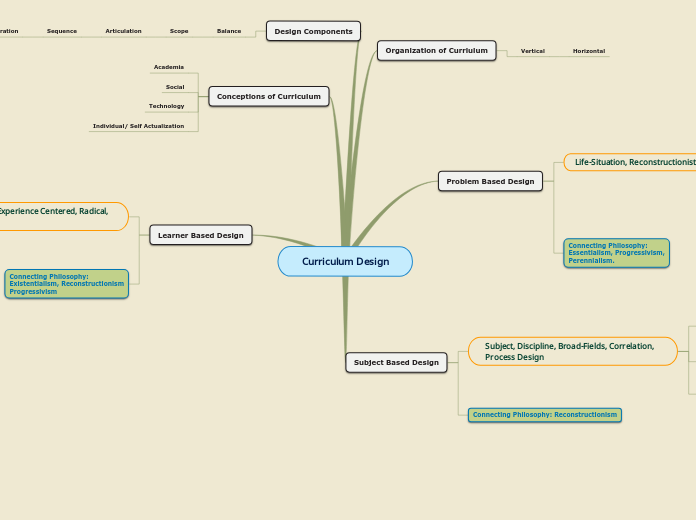Curriculum Design
Organization of Curriulum
Vertical
Horizontal
Problem Based Design
Life-Situation, Reconstructionist
Planning
Interdisciplinary and based on real-life
scenarios. Independent and self- directed
learning. Teacher plans learning goals, students have
input and direct the learning/projects.
Instruction
Opportunities for several pathway/modality.
Learning outside classroom, Case studies
debrief and reflection . Teacher
and student work together to challenge idea at
hand and lead the direction of activities/research.
Assessment
Final assessment synthesizes the
students research, solutions, and
learning. Student self assessments,
self reflection, individual and group
rubrics, individualized specific feedback
based on outcome of learning.
Connecting Philosophy:
Essentialism, Progressivism,
Perennialism.
Subject Based Design
Subject, Discipline, Broad-Fields, Correlation, Process Design
Planning
Teacher plans without student input. Plans to
meet learning objectives outlined in curriculum to meet
grade level.
Instruction
Instructional lessons and activities use of
course materials and textbooks. Emphasis is placed
on acquisition, memorization, and knowledge of each
specific content area.
Assessment
Benchmarks and looking to meet set standards. Formal testing, unit exams, multiple choice or a structured response.
Connecting Philosophy: Reconstructionism
Design Components
Balance
Scope
Articulation
Sequence
Integration
Continuity
Conceptions of Curriculum
Academia
Social
Technology
Individual/ Self Actualization
Learner Based Design
Child-Centered, Experience Centered, Radical, Humanistic
Planning
Teacher plans with student choice and
interest in mind. Activities geared to
meet students needs/desires.
Instruction
Instruction is done through inquiry,
problem based learning, games, and
cooperative learning.
Assessment
Assessment 'for' and 'as' learning. Peer, self
assessment and direct conversation with teacher.
Connecting Philosophy:
Existentialism, Reconstructionism
Progressivism
